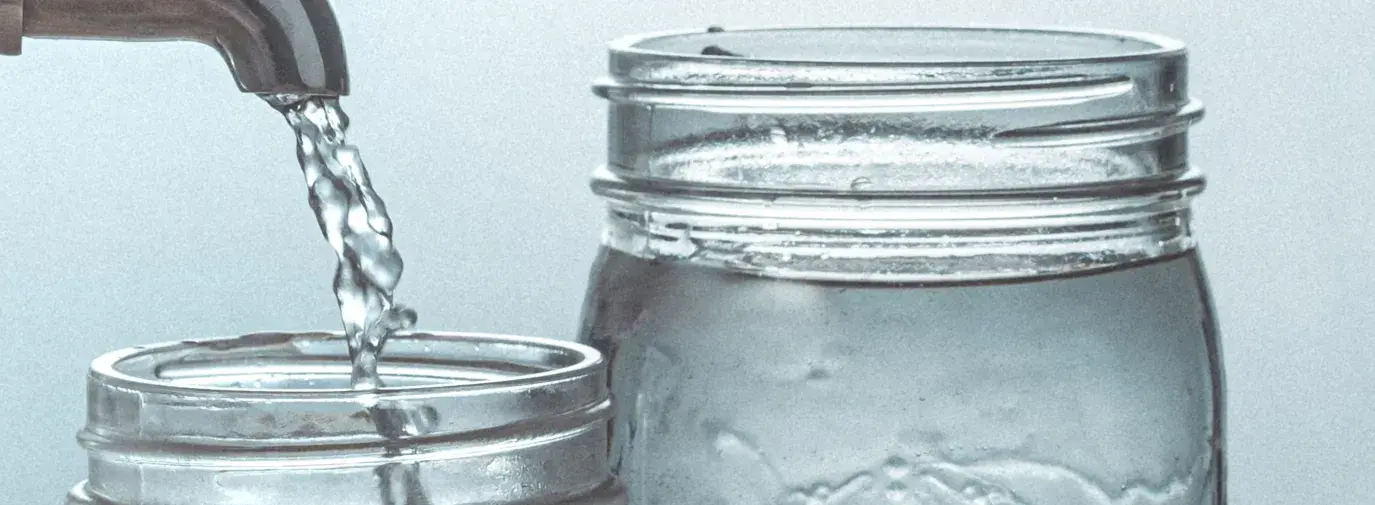
First time here? Check out the most recent and updated version of this article: Bottled Water VS. Tap.
Water is life. Some of us drink it straight from our faucet without a second thought. Others go to great lengths to buy enough jugs or bottles from the store to always have on hand. Safe water isn’t straightforward— but the best-for-you, best-for-the-planet solution is water filtration.
Though utilities will claim that their water meets all Environmental Protection Agency (EPA) standards, the fact is that the EPA isn’t doing all it could to protect Americans from toxic chemicals in our water supply. Its science can be decades out of date and it bases recommendations on chemical levels on cost-benefit analyses which may not put enough value on community health, according to Sydney Evans, science analyst at the Environmental Working Group (EWG) who works on the organization’s tap water database. She says filters are the best option for households today, and infrastructure development is the best way to secure safe water for the future. Follow these three steps to ensure your drinking water is as safe as it can be.
Step 1: Don't Drink Bottled Water
Americans are buying bottled water now more than ever, perhaps because they don’t trust their tap water. Bottled water accounted for 25% of beverage consumption in the US as of 2018, according to research by Statista. But research from the Barcelona Institute for Global Health reported in 2021 that the impact of bottled water on natural resources is 3,500 times higher for bottled water than tap, and the impact on ecosystems was 1,400 times higher. In the US, 17 million barrels of oil are used per year just to meet plastic water bottle demand. Nonprofit Ban the Bottle has reported that 24%of bottled water is just municipal or tap water—only sometimes put through extra filtration.
Since bottled water is a packaged product, it’s regulated by the Food and Drug Administration (FDA), which in some respects has looser guidelines than the EPA, which regulates tap water. For example, the FDA requires bottled water to be assessed for coliform bacteria, an infection-causing pathogen, once a week. The EPA requires community water systems to test their water multiple times a day.
Bottled water also leads to grim circumstances for both the environment and society. According to the Container Recycling Institute, 75% of the 70 billion water bottles sold in the US in 2018 ended up as litter or in the landfill. It takes three liters of water to make a plastic bottle that will hold one liter of water, and it takes over 1,000 years for that bottle to biodegrade, states EarthWatch.
A lesser-known fact, confirmed by the nonprofit Food and Water Watch, is that employees at bottled water plants often receive low wages and are injured at a rate 50% higher than the overall manufacturing industry and the construction industry.
Bottled water poses risks to health, workers, and the environment. But what if your tap water has contamination issues?
Step 2: Get to Know Your Water
Water filters offer people an active role in improving their water quality without plastic waste. Plus, you’ll save money: a study from Penn State found that skipping plastic bottled water can save a family of four about $5,000 per year.
If you get water through a utility, check your local contaminants. In a review of 140,000 public water systems across the US, The Guardian found that 25 million Americans are drinking from the worst water systems—those that accrued more than 15 standards violations over five years. Income, geography, and race are the most likely to affect one’s access to clean, water, with poor, rural, and Latinx Americans the least likely to have clean water.
For a robust look at your local water, visit the EWG’s Tap Water Database which lists the contaminants found in 50,000 water systems across all 50 states over multiple years. This resource notes any violations of federal legal contaminant limits a utility may have incurred, as well as what the legal limits are for each contaminant, and the negative health effects associated with that contaminant.
Evans explains that the EPA’s standards weigh the lab studies on the safety of chemicals against the cost of municipalities actually filtering those chemicals out.
“Many EPA standards are based on research and technology and costs that are now decades out of date. About 90 contaminants are regulated, but there are hundreds detected regularly in our drinking water. But in spite of that, no new chemical contaminants have been regulated in about 20 years,” Evans says. “That’s why we publish our own guidelines— because our guidelines make no such compromises. They are based purely on health outcomes and take into account sensitive populations.”
If you access water from a private well, your local government does not test your water, so you will need to send it to a lab to test for coliform bacteria, nitrates, dissolved solids, pH levels, and other suspected contaminants. EWG recommends a certified lab to test for contaminants, which goes beyond what a home test can detect. Find a lab to do a state-certified test on the water in your home by consulting the EPA’s Drinking Water and Wastewater Laboratory Network.
Step 3: Find the Best Filter for You
Different filters work on different contaminants so there is no one universal “best filter.” At the end of the day, a filter only works if it filters out the actual pollutants in your water.
NSF International and the Water Quality Association are public health organizations that certify water filters for safety and effectiveness. Check a water filter before you buy that it’s certified by one of these organizations.
Which Filter Do I Choose?
Carbon:
Carbon bonds with and removes contaminants from your water. Pitcher filters like Brita are usually carbon filters. Maintenance includes replacing filters on a schedule, as once the filter is “full” of contaminants, it can start releasing them back into the water.
Best for: Chlorine and chemical byproducts of disinfection from your utility. Some types will also remove asbestos, lead, mercury, and VOCs (check packaging). These tend to be the least expensive filter type.
Cons: Quality can vary widely, and they won’t remove pollutants including arsenic, fluoride, nitrate, and others.
Ion exchange/water softeners:
A special type of resin is used to attract excess magnesium and calcium. These filters are mechanical and tend to last about a decade— maintenance may include repairs by a professional, and the resin in the system will need to be replaced periodically. These can be installed under a single sink or for an entire house system.
Best for: reducing the level of calcium, magnesium, barium, and radium which can build up in pipes or occur naturally in tap water.
Cons: Levels of other contaminants won’t change. Also, softened water replaces minerals it removes with sodium, so softened water isn’t recommended for people with low sodium diets, or for watering plants.
Reverse Osmosis:
These filters push water through a membrane that blocks contaminants. Those sold for home use often include carbon and/or sediment filters as well. EWG has named reverse osmosis as the most effective filtration system. These systems can also be installed under specific sinks or for a whole house.
Best for: Arsenic, fluoride, hexavalent chromium, nitrates, and perchlorate.
Cons: Uses a lot of water—taking in about five times as much water as they produce. They also remove important minerals such as iron, calcium, and magnesium.
You may have heard of other types of filtration methods—some are more focused on pathogens and bacteria, which are useful if you are drinking untreated water. Others on the market, like ceramic filters, do not work well enough to filter out chemicals, says Evans. For filtering chemicals from treated water, stick to the main three above.
Why We Need More Than Filters:
Water filters are far better for the environment than bottled water—even if they waste some water or require maintenance and filters that must be replaced.
Evans says filtering water can have unmeasurable positive effects on our health. We drink unfiltered tap water today and are fine today. But based on research by EWG, many utilities are providing their customers water with chemicals that may cause serious health impacts over the course of a lifetime. Filtering water is a great step that we have control over.
But a filter is just a bandage. Evans says more often than not, communities that need improved water quality the most are the ones that are least likely to be able to afford a filtration unit.
For example, in Flint, MI, chronic quality issues were overlooked even as Flint residents became sick and children were poisoned by lead. It’s no coincidence that this community being denied access to clean, affordable water is majority Black with a nearly 40% poverty rate. The Flint water crisis was an environmental justice issue. Needing to buy a filter to access clean water is an environmental justice issue as well.
“There’s sometimes this disconnect between what we advocate for and what’s reasonable for individuals, because there’s an emotional burden to this as well,” says Evans. “Today you’re told you need a water filter. And yesterday, it was PFAS and nonstick cookware, and tomorrow, it’s pesticides in your food. All of these issues are important issues with serious health consequences that can be overwhelming. The ultimate solutions need to come at the community and the national level.”
Evans recommends investment in infrastructure so the utilities have the resources they need to protect the communities they serve, whether or not those people can afford filters. After you see what contaminants are present in your water, reach out to local legislators and ask what they can do, and what you can do, to support the safe water in your area.
Whether you're a water enthusiast or disdainful hydrator, it's a human right to have access to clean and healthy water. Optimize your tap for you and your family by investing in responsible and efficient water filtration systems.







